| Vang stone | |
|---|---|
 | |
| Created | Eleventh century |
| Discovered | Vang, Oppland, Norway |
| Rundata ID | N 84 |
| Runemaster | Gása |
Vang stone (Vangsteinen) listed as N 84 in Rundata is a runestone from the early eleventh century located at Vang in Oppland, Norway. [1] [2]
| Vang stone | |
|---|---|
 | |
| Created | Eleventh century |
| Discovered | Vang, Oppland, Norway |
| Rundata ID | N 84 |
| Runemaster | Gása |
Vang stone (Vangsteinen) listed as N 84 in Rundata is a runestone from the early eleventh century located at Vang in Oppland, Norway. [1] [2]
The Vang stone was erected around 1000, during the transitional period from Paganism to Christianity in Norway. It was originally located in the traditional district of Valdres. It was situated outside a stave church at Vang. Vang Stave Church was dismantled and moved to Krummhübel, Germany in 1844. At that time, the runestone was moved to its current location, outside the Vang Church (Vang kirke). [3] [4]
The stone is made of an irregular slab of slate. It is 2.15m tall, up to 1.25m wide and 8–13 cm thick. The artwork on the front of the stone is in Ringerike style, and depicts ribbons, leaves and a stylized animal, allegedly a lion. [5] Although thought to be a part of a stone portal, this idea is generally not supported. In contrast to other Viking Age runestones. The runic text is not integrated with the artwork to make a unified composition, but is carved along the edge of the stone. [5]
kosa
Gása
:
sunir
synir
:
ristu
reistu
:
s(t)in
stein
:
þinsi
þenna
:
af(t)ir
eptir
:
kunar
Gunnar,
:
bruþur:sun
bróðurson.
Gasi's sons raised this stone in memory of Gunnarr, (their) nephew. [6]
The Funbo runestones constitute a group of four runestones originally from Funbo in the province of Uppland, Sweden, which were raised by members of the same family during the eleventh century.
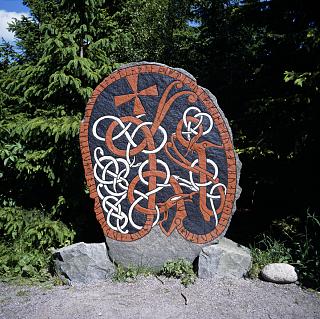
U 871 is a 12th-century runestone in the Rundata catalog, originally from Ölsta, a village in the county of Uppland in Sweden. It is now on display at Skansen, near Stockholm.

The Granavollen stone is a runestone located behind Nikolaikirken at Granavollen in Gran, Oppland county, Norway. This church is also known as one of the two medieval Sister Churches. The inscription is classified as being carved in runestone style RAK, which is the oldest style. This classification is used for those inscriptions where the ends of the runic text bands are straight and do not have any animal or serpent heads attached.

Burestenen, or Nolbystenen, listed in Rundata as M 1, is a memorial runestone located in the Swedish province of Medelpad.

Danish Runic Inscription 66 or DR 66, also known as the Mask stone, is a granite Viking Age memorial runestone that was discovered in Aarhus, Denmark. The inscription features a facial mask and memorializes a man who died in a battle.
The Ingvar runestones is the name of around 26 Varangian Runestones that were raised in commemoration of those who died in the Swedish Viking expedition to the Caspian Sea of Ingvar the Far-Travelled.
The Klepp I Runestone, listed as N 225 in the Rundata catalog, is one of two runestones from Klepp in Rogaland, Norway. It is among the few Viking Age runestones that was raised as a memorial to a woman.

The Hagby Runestones are four runestones that are raised on the courtyard of the farm Hagby in Uppland, Sweden. They are inscribed in Old Norse using the Younger Futhark and they date to the 11th century. Three of the runestones are raised in memory of Varangians who died somewhere in the East, probably in Kievan Rus'.
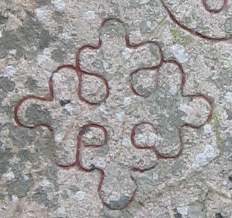
The Risbyle Runestones are two runestones found near the western shore of Lake Vallentunasjön in Uppland, Sweden, dating from the Viking Age.
The England runestones are a group of about 30 runestones in Scandinavia which refer to Viking Age voyages to England. They constitute one of the largest groups of runestones that mention voyages to other countries, and they are comparable in number only to the approximately 30 Greece Runestones and the 26 Ingvar Runestones, of which the latter refer to a Viking expedition to the Caspian Sea region. They were engraved in Old Norse with the Younger Futhark.

The Varangian Runestones are runestones in Scandinavia that mention voyages to the East or the Eastern route, or to more specific eastern locations such as Garðaríki in Eastern Europe.
The Viking runestones are runestones that mention Scandinavians who participated in Viking expeditions. This article treats the runestone that refer to people who took part in voyages abroad, in western Europe, and stones that mention men who were Viking warriors and/or died while travelling in the West. However, it is likely that all of them do not mention men who took part in pillaging. The inscriptions were all engraved in Old Norse with the Younger Futhark. The runestones are unevenly distributed in Scandinavia: Denmark has 250 runestones, Norway has 50 while Iceland has none. Sweden has as many as between 1,700 and 2,500 depending on definition. The Swedish district of Uppland has the highest concentration with as many as 1,196 inscriptions in stone, whereas Södermanland is second with 391.

Arkils tingstad is the remains of the Viking Age thing or assembly location of a hundred in Uppland, Sweden. It is situated on the outskirts of Stockholm. The remains consist of a rectangular stone formation and two runestones.

The Manx runestones were made by the Norse population on the Isle of Man during the Viking Age, mostly in the 10th century. Despite its small size, the Isle of Man stands out with many Viking Age runestones, in 1983 numbering as many as 26 surviving stones, which can be compared to 33 in all of Norway. So many of them may appear on the Isle of Man because of the merging of the immigrant Norse runestone tradition with the local Celtic tradition of raising high crosses.
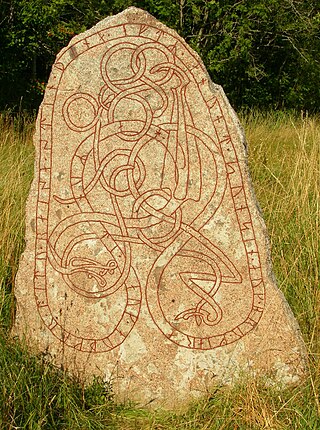
This runic inscription, designated as U 839 in the Rundata catalog, is on a Viking Age memorial runestone located in Ryda kungsgård, which is about 6 kilometers north of Enköping, Uppsala County, Sweden, and in the historic province of Uppland.
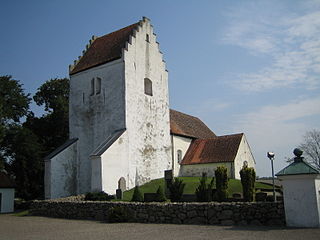
The Skårby Runestones are two Viking Age memorial runestones originally located in Skårby, which is about ten kilometers northwest of Ystad, Scania, Sweden.
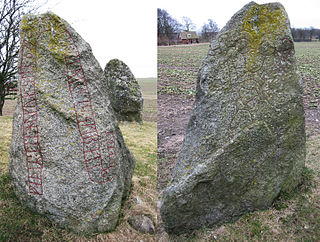
The Västra Strö 2 Runestone, listed as DR 335 in the Rundata catalog, is a Viking Age memorial runestone located at the Västra Strö Monument, which is at a church that is about four kilometers northwest of Eslöv, Skåne County, Sweden.

The Västra Nöbbelöv Runestone, listed as DR 278 in the Rundata catalog, is a Viking Age memorial runestone located in Västra Nöbbelöv, which is about 3 kilometers east of Skivarp, Skåne County, Sweden, and was in the historic province of Scania.
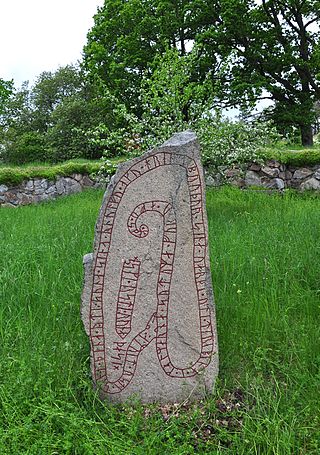
The Södermanland Runic Inscription 333 is a Viking Age runestone engraved in Old Norse with the Younger Futhark runic alphabet. It is located at the abandoned Ärja Church in Strängnäs Municipality. The style of the runestone is a categorized as Fp.

Södermanland Runic Inscription 113 is the Rundata catalogue index for a 0.9 metres (35 in) high, 0.5 metres (20 in) wide granite runestone in Kolunda, Stenkvista Parish, Eskilstuna Municipality, Sweden, within the historic province of Södermanland. It was found in 1856 on a hill believed to have once had many other graves and monuments, and is believed to have originally stood atop a burial mound before falling over and being buried. It has since been moved, and now stands next to the runestone known as Sö 112 and a partial runestone discovered in 1997. Its inscription in the Younger Futhark alphabet when translated into English reads "They placed the stone here, the sons of Þorketill and Folka, in memory of father and mother. [They] made [it] valiantly."